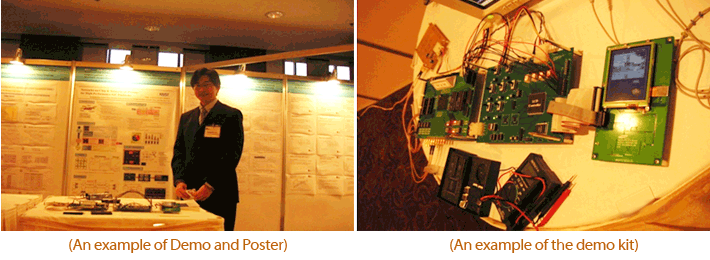 |
Information |
About 9 outstanding chip designs reflecting the high research standards of Asian as well as worldwide academies are selected among the accepted student papers and honorably invited to demonstrate their design results on the conference site with poster. Based on the on-site demonstration results, 3 best student designs will be selected and awarded. The other participants will be honored by A-SSCC SDC certificates.
 |
General Guidelines |
The SDC session is intended to provide an interactive demonstration of excellent student designs. Authors can demonstrate their design results, operations and detail concepts vividly to the conference participants.
Authors should bring their chip and test/demonstration equipments to the conference site to demonstrate their design results during the conference period; from the first day till the second day of the conference (The first day (Nov. 14) demonstration is very important because the award winners are determined by the demonstration review on the first day).
The operation of the chip will be demonstrated by showing the important waveforms verifying the design concepts or by showing visual criterions for the performance of the chip.
Although it is not recommended, the authors may bring the test result data stored in the notebook and replay them at the conference site instead of the real demonstration.
Most of the test equipments necessary for the demonstration should be brought by the authors themselves (The notebook type test equipment is recommended). However, if you need any special equipment for the on-site demonstration, please contact the SDC chair, Prof. Shiho Kim (shiho@yonsei.ac.kr) or Prof. Masaki Hirata (m-hirata@fc.ritsumei.ac.jp) at your earliest convenience.
*Presenters are responsible to pay off special equipment fee prior to the conference. Please contact the A-SSCC Secretariat for detail payment information.
The poster boards are prepared to attach the posters in portrait format with a maximum size of 70 inches (height) by 36 inches (width) (1 inch=2.54 cm). Posters have to be attached to the boards using adhesive tape (available on site). The poster should allow the attendees to recognize the key points of the work easily from a distance of at least 10 feet (3 meters) and to facilitate more detailed discussions with the authors. Often the best poster comprises a few large significant graphs/illustrations annotated clearly with only enough text to headline key points like purpose, conclusions, and impact. Note that the poster should not consist of a copy of the manuscript.
 |
Specific Guidelines |
| - |
A 1.83m X 0.45m X 0.76m (Length X Width X Height) platform will be placed in front of the each poster board for the design demonstration. Power socket and wireless internet will also be provided. |
| - |
Please prepare a self complete test board in order to avoid the necessity of the external test equipments such as the function generator or large oscilloscope. |
| - |
An area 12 in. high and 9 in. wide in the top left corner of the poster board will be used for poster identification. |
| - |
The poster will typically consist of a number of 8.5 x 11 in. or A4 pages tacked to the bulletin board, although larger paper formats are acceptable and even desirable. |
| - |
One page is to consist of the paper title, authors and affiliation. |
| - |
A second page is to consist of a brief abstract outlining the key points of the paper. |
| - |
Use a minimum font size of 18 points for text and 30 points for headings. |
| - |
Limit text to 4-6 key points per page. |
| - |
Limit graphs or illustrations to 2 per page. |
| - |
Appropriate use of color is encouraged. |
| - |
Electric Outlet: 220V |
